#spiritual connection and reflection for queer Muslims
Text
belated Ramadan Mubarak!
I try to do a bit of reading every Ramadan, so, for accountability, and so that when I inevitably don’t get through them I can find my list next year—here's my (extremely very ambitious) reading list for this year!
(suggestions are very welcome, with the warning that I very much may not get through them. this year, I’m trying to learn more about Islam and liberation theology and I’m trying to read more abolitionist texts, and of course my standard queer Muslim books, I’m trying to read more poetry by Muslim poets I don’t know well, and every Ramadan I try and only read fiction by Muslim authors, so there’s some sff on here too!)
non-fic:
memoirs:
We Have Always Been Here by Samra Habib (reread)
Hijab Butch Blues by Lamya H
The Colour of God by Ayesha S Chaudhry
Love is an Ex-Country by Randa Jarrar
A Dutiful Boy by Mohsin Zaidi
other nonfic:
Islam and Anarchism by Mohamed Abdou
We Do This Til We Free Us by Mariame Kaba (reread-ish? I never fully finished it)
Let This Radicalise You by Kelly Hayes and Mariame Kaba
Qur'an and Woman by Amina Wadud (which I also never finished)
The Women's Khutbah Book by Fatima Seedat and Sa'diyya Shaikh
Qur’an of the Oppressed: Liberation Theology and Gender Justice in Islam by Shadaab Rahemtulla
With Stones in Our Hands: Writings on Muslims, Racism, and Empire by Sohail Daulatzai and Junaid Rana
fiction:
The Candle and the Flame by Nafiza Azad
Mirage by Somaiya Daud (yes I still have not read this)
The Light at the Bottom of the World by London Shah
Roses, in the Mouth of a Lion by Bushra Rehman
A Tempest of Tea by Hafsah Faisal
poetry:
Halal If You Hear Me (anthology)
If They Come For Us by Fatimah Asghar (reread)
Hagar Poems by Mohja Kahf
Bad Diaspora Poems by Momtaza Mehri
The Fortieth Day by Kazim Ali
Black Seeds by Tariq Touré
Postcolonial Banter by Suhaiymah Manzoor-Khan
#books#salmon’s muslim tag#text post#my post#yes it’s a very long reading list#idk I am in a reading place right now and I’m running some stuff on#spiritual connection and reflection for queer Muslims#later in the month#using some truly incredible resources that others have prepared but I gotta do some prep of my own too yknow#and idk I haven’t really been connected to Islamic learning in a while?#and I like doing it!#I think it’s important for the kind of stuff and reflection I do#so let’s see how well this goes#I feel like I should’ve made a different Ramadan Mubarak post as well but I did not so#you get my reading list instead
17 notes
·
View notes
Text
On Representation: A review of The Tyrant’s Tomb
It’s still too early to go to sleep and I have nothing better to productively do, so: time for me to rant angrily about representation.
IMPORTANT WARNING: this will include some (probably minor?) spoilers for The Tyrant’s Tomb by Rick Riordan. Since I’m pretending it’s a review of that book even though it is really just my angry thoughts about representation that were prompted by it. There will also be (definitely minor) spoilers about a character in Rick Riordan’s Magnus Chase and the Gods of Asgard series.
Edit: this rant is long, in addition to the spoilers, so please (but actually, please) read it after the cut.
Okay. First of all: I enjoyed The Tyrant’s Tomb. I’ve been loving the Trials of Apollo series, and this is no exception, and I’m excited for the next book. But.
I have ranted, a lot, about representation before, because I so rarely see Jewish characters in books not written exclusively by and for Jews, and even rarer do I see observant Jewish characters in any media not created exclusively by and for Orthodox Jews. And obviously, I want to feel reflected in at least some of the mainstream media I consume.
The important preface to this rant is a quick review, though I have discussed this, too, before, of the intense pleasure and pain brought on by reading the character of Samirah al-Abbas in Rick Riordan’s Magnus Chase books. Samirah was almost, almost, almost the Holy Grail of “observant religious character” that I had described, almost to a T, of what I am constantly seeking in media: she was a major character, whose religion was a major part of her life in tangible ways throughout the books - from wearing her hijab, to observing modesty in her interactions with her fiance, to performing heroics while fasting for Ramadan - and yet who was characterized well enough that her religion, while inextricably an important part of her life, wasn’t her entire character, either. It was beautiful; it was magnificently done.
And it broke my heart. Because God knows observant Muslim people have deserved Samirah for so long; but her existence on these pages only drove home to me that what I was looking for was possible and yet, impossibly, I still didn’t have it. Samirah was fantastic, but she still wasn’t the representation that I was looking for: I wanted, and still want, those traits, but for a Jewish character, in whom I can see something of myself. I want Samirah, but I want that for me, too.
Flip ahead a couple years (and a few more representation in media rants) to me picking up and reading The Tyrant’s Tomb. I’d pre-ordered it in the summer, while ordering a few books as a birthday present to my sister, and promptly forgotten about it, so when it arrived, it was like a delightful gift from Past Me.
I started reading, and I was so, so excited when the character of Lavinia was introduced, right near the beginning of the book. Right away, Riordan telegraphed that she was both Jewish and queer, with the Magen David necklace and her interest in a female dryad. I was primed and ready to both love her and see myself in her.
And then I was let down.
Now, before I dig deep into the many ways in which Lavinia was a complete and utter disappointment, I want to offer an important caveat, referring to my preface about Samirah. I don’t want to give the impression that I’m castigating Riordan for trying, when so many other mainstream writers don’t. At least he made her canonically Jewish on-page, rather than hiding behind a Jewish-sounding last name and then declaring it to be the truth off-page (looking at you, Rowling and Anthony Goldstein). At least there is a Jewish character in his books (looking at... almost every other mainstream YA fantasy series I’ve ever read not written by Jews).
But the thing is, we raise our expectations of people based on what we know they are capable of. I’m a teacher; a level 3 “Meets Expectations” is going to look different for my academically-struggling student who is working really hard to improve, as opposed to my bookworm student who started the year off by turning in a long and erudite personal essay.
Most of those other mainstream YA fantasy writers, I don’t have any expectations of. Whereas Rick Riordan, the man who created Samirah al-Abbas: I know exactly what he is capable of. Which is why it hurts so much more that, when it comes to a Jewish character, he falls so strikingly short.
I’ll be fair: I wasn’t expecting a second, Jewish Samirah from him. That wouldn’t be reasonable. I would like that, someday, from someone, but that will have to be in someone else’s book; it wouldn’t make sense for Riordan to retread the exact same ground, and I understand that.
And Lavinia didn’t have to be observant - as I’ve recognized, he already has Samirah for that. But I was hoping, expecting, for her to be something more than Jewish In Name Only. (Strike that: she may have been Jewish on-page, but Riordan never even used the J word. He wrote around it. Why? I don’t know. Presumably not just to disappoint me.)
So what’s wrong with Lavinia? And how could he have done better with her?
Great news: I’ve got a bulleted list to help with that, starting with the simple and working our way up.
To start with: her last name. I’ve been going over and over this dozens of times, and I still can’t quite work out why, for his one Jewish character, Riordan decided to give her the last name of one of the most famous Jewish speculative fiction writers, and then (a) never once acknowledge this connection, and (b) acknowledge that she shares her name with a famous Jewish... fictional dancer. Why Asimov, if he wasn’t going to say anything at all about the Asimov?
Continuing with her name: her first name. I get that Riordan likes to give Romanesque names to the Roman demigods, but this overlooks the fact that the demigods are almost always named by their human parent; and while Sally Jackson had her reasons for naming her son after a Greek hero, most Jewish parents will give their child a Jewish name, if not the actual name of a recently-deceased relative. But okay. Fine. I wouldn’t want to mess with the thematic naming in the book; but how about a name that evokes the intersection of Roman and Jewish history: Salome, or Salome Alexandra, for instance?
Speaking of that intersection of Roman and Jewish: I’m still too relieved at finding a Jewish character, any Jewish character, in his books, to be offended that this Jewish character ends the book as a centurion in a Roman army, but - she should be. Lavinia should, at some point in the book, have expressed discomfort at the Roman side of her heritage, as it intersects with her Jewish culture and history. And it would have been so easy: throughout the book, Lavinia has problems with authority and with the structures of the Legion in particular. Just once, she could have defended that rebelliousness - honestly or not - with a reference to how the Roman legions once destroyed her people’s Temple, razed her homeland, and subjugated her people with an exile that is still, in many ways, ongoing to this day. Not in so many words, obviously; I’m not asking Riordan to write it the way I did. Just something like “Yeah, well, Roman Legions and Jews aren’t usually a good mix.” Or here’s another way she could have expressed her Roman discomfort: in that conversation about awkwardness. Instead of “You want awkward? Try telling your Rabbi that you’re taking a girl as your date to your Bat Mitzvah,” she could have said: “You want awkward? Try being a Jewish demigod.” “You want awkward? Try being a queer Jew in a Roman legion.”
SPEAKING OF THAT INSANE AND PERPLEXING COMMENT ABOUT RABBIS AND BAT MITZVAHS, I have so so so many problems with that line:
First of all, given the premise that Lavinia as written is very clearly not an observant Jew by any means or interpretation, and does not appear to have any Jewish community ties, it is strange to me that she speaks about having a rabbi. Typically, people who have a rabbi are either (a) observant people who go to this rabbi with religious questions, or (b) community-oriented people who see the rabbi of their community (or another chosen spiritual leader in their chosen community) as their rabbi. Lavinia appears to be neither, so why “try telling your rabbi that...” and not, say, “try telling the rabbi at your shul that...”?
Okay but forget whose rabbi this is: why is she telling the rabbi about her date? Why is that necessary? For those (like Rick Riordan??) unfamiliar with what a Bat Mitzvah is: A Bat Mitzvah is actually the term for a (female) person who has reached the age of religious responsibility in Judaism, and it happens automatically when a girl turns 12 (and for a boy - Bar Mitzvah - when he turns 13). But okay, I’ll stop being so pedantic, and agree that Riordan, and Lavinia, were obviously referring to the party that is commonly held to celebrate this milestone. But that’s all it is: a party celebrating a milestone. Although there is often a prayer service and/or a Torah reading, there is no ritual aspect to a Bat Mitzvah celebration. Other than, again, perhaps the prayer service / Torah reading, there is definitely nothing you would need to inform a rabbi of. You would definitely not be telling the rabbi about your guest list, unless the rabbi is your parent/guardian / the person paying for the party.
But never mind who she’s telling about her date: did you miss the part where I noted that a Bat Mitzvah is for a girl turning twelve. Speaking as somebody who has celebrated a Bat Mitzvah for myself, and who has attended many such celebrations as a guest, I can tell you beyond a shadow of a doubt: you do not invite a date to this event, whether you are a guest or the girl of honour. For one thing, you are twelve. Twelve is too young to be bringing dates! For another, you’re going to a party full of twelve-year-olds, where there will be maybe a prayer service and then a nice meal and then probably a bunch of twelve-year-olds bopping around to some obnoxiously loud music. I get Lavinia’s trying to let us know she was already very gay when she was twelve, but that does not explain bringing a date, female or otherwise, to her own Bat Mitzvah. Just ask the girl as a normal guest and then awkwardly ask her to dance, for heaven’s sake!
In conclusion, that entire sentence made no sense, and it really only accomplished two things: (a) it gave me the impression, rightly or wrongly, that Riordan knows absolutely nothing about Judaism; and (b) it strongly implied, unfairly, that rabbis in general are homophobic, which it why it was so awkward for Lavinia to tell her rabbi about her nonsensical date.
Throughout the book, Lavinia’s big crusade is ecological safety, protecting the nature spirits and the environment, and the homeless people living in the park who would be impacted by the Emperors’ attacks. It would have been so easy to infuse this important aspect of her personality with her Jewishness, by just letting her throw around the term “tikun olam” in that context. It would have absolutely fit with the culturally-not-religiously Jewish air he was clearly going for, and it would have made her seem 10,000% more authentically Jewish to me, with just, my God, two words added to the entire book.
You want another way to make her seem more realistically, three-dimensionally Jewish? How about, oh, I dunno, her one Jewish parent? (By the way: it has not slipped my attention that Lavinia’s one Jewish parent is her father, meaning that except by Reform definitions, she’s not, technically, Jewish at all; just canonically connected to Jewish culture. Are paternal Jews who consider themselves Jewish valid and Jewish? Of course. Am I nonetheless extremely disappointed that he’s managed to water down the Jewishness of his one Jewish character in 20+ books in this additional way? Absolutely.) Apollo showed great interest in asking her about her father, the famous Asimov... dancer (I’m sorry, I still can’t get over that he named her Asimov and did not make a single reference to Asimov; is Isaac Asimov the only Jew he’s ever heard of or something???). She could have alluded to his Jewishness. “Yeah, Sergei’s still mad that I stopped coming to our Asimov family Seders.”
Instead, other than the absurd-and-mildly-offensive rabbi-and-Bat-Mitzvah line, what is the only evidence we have that Lavinia even is of Jewish descent? Ah, yes. The thing that got me so excited in the first place, as - or so I thought - a hint of Jewishness to come: her Magen David necklace. Except of course, Riordan only ever calls it a “Star of David,” because - okay, that’s what Apollo would call it in his narration, and of course Lavinia never said a word about it, despite all the times she played with it. Never explained where she got it from, or why she wore it, or what made it so important to her. So it had no sentimental or cultural value conveyed to the reader. It was just a visual cue to tell us: “Jewish character.” It was as anemic and anodyne a way of making her Jewish as the Menorah-on-the-Mantelpiece trick that I’ve often complained about in TV shows that want to suddenly establish a character is Jewish - except worse, because at least with a Menorah on the mantel, we’ve got the implication that somebody lights it (if it’s a Chanukiyah) on Chanukah. This is just a star, on a necklace.
In conclusion: Lavinia could have been great. She could have been a queer Jewish demigod, passionate about nature and about tikun olam, complex and uncomfortable with her role as a Jewish person in the Legion despite her absolute commitment to helping her friends survive the attack and defeat their dangerous enemies.
Instead, she was a disappointment. She was characterized well, for what she was. But what she was was a girl with a necklace. A queer Roman demigod with a famous dancer father.
I started this rant expecting to call her Jewish in name only. But she wasn’t even that.
Perhaps it’s unfair of me to call Lavinia a disappointment, from how anemic her Jewishness was. The real disappointment in The Tyrant’s Tomb was Rick Riordan.
#representation#jewish representation#representation done right#representation done wrong#representation in media#representation matters#trials of apollo#the tyrants tomb#rick riordan#lavinia asimov#am i jewish tumblr#rant#representation rant#review#not actually a book review#not lies either though#judaism#failed representation#samirah al abbas
61 notes
·
View notes
Text
Social Justice
WE ARE THE RADICAL MONARCHS
Directed by Linda Goldstein Knowlton
Follows the Radical Monarchs, a group of young girls of color on the frontlines of social justice.
Set in Oakland, a city with a deep history of social justice movements, WE ARE THE RADICAL MONARCHS documents the Radical Monarchs--an alternative to the Scout movement for girls of color, aged 8-13. Its members earn badges for completing units on social justice including being an LGBTQ ally, the environment, and disability justice.
The group was started by two fierce, queer women of color, Anayvette Martinez and Marilyn Hollinquest as a way to address and center her daughter's experience as a young brown girl. Their work is anchored in the belief that adolescent girls of color need dedicated spaces and that the foundation for this innovative work must also be rooted in fierce inter-dependent sisterhood, self-love, and hope.
The film follows the first troop of Radical Monarchs for over three years, until they graduate, and documents the Co-Founders' struggle to respond to the needs of communities across the US and grow the organization after the viral explosion of interest in the troop's mission to create and inspire a new generation of social justice activists.
DVD / 2020 / (Grades 4-12, College, Adults) / 86 minutes
CONCERNED CITIZEN, A: CIVICS IN ACTION
Directed by Bo Boudart
A CONCERNED CITIZEN documents the work of Dr. Riki Ott, a whistleblower who predicted the Exxon Valdez oil spill hours before it happened and came to the aid of her Alaskan community in their battle to get fair compensation for their loss of health and income.
More recently Riki, a toxicologist, author, and activist, has been organizing the Gulf coast communities as they struggle to recover from the BP Deepwater Horizon disaster. Taking the lessons she learned as an activist, she is also spearheading the campaign called Ultimate Civics, a complete civics curriculum she developed that empowers students to participate in their democracy. Recognizing the power of money in politics she advocates for a constitutional amendment to end corporate personhood, and to reform campaign finance laws. She lectures nationally and internationally, inspiring students from fifth grade through universities and adults to take action and showing by example how one person can make a difference.
"It is my hope that, as people's health, livelihoods, and property are harmed by these extreme oil activities, people will understand the need to shift off oil to safer energy options and take action to achieve true energy independence. This is the movement that I see growing in all regions of our country."
DVD / 2019 / (Grades 7-12, College, Adults) / 41 minutes
HAIDA MODERN: THE ART & ACTIVISM OF ROBERT DAVIDSON
Directed by Charles Wilkinson
Portrait of Haida artist, Robert Davidson, whose art and activism point the way towards a renewed connection with the natural world, perhaps saving us from ourselves.
Haida artist Robert Davidson is one of the foremost cultural icons of the age. HAIDA MODERN features candid and revealing conversations with the artist himself, along with commentary from art historians, politicians, musicians and family members detailing the importance and impact of Davidson's work. Highlighted in these conversations is the story of how Davidson carved the first totem pole raised on the island of Haida Gwaii in over 100 years - a spiritual and political act credited with sparking a reawakening of Indigenous culture in the Pacific Northwest.
In HAIDA MODERN, we see how Indigenous and non-Indigenous citizens alike-inspired by Davidson's art-are coming together to forge political movements led by Indigenous activists and artists, fighting the critical environmental battles of our time. That is the great and enduring power of Robert Davidson's 14,000 year old indigenous Haida culture: the power of an art so beautiful, it must be seen over and again.
DVD / 2019 / (Grades 7-12, College, Adults) / 80 minutes
WHO'S NEXT?
Directed by Nancy Cooperstein Charney
Examines the effects of hate speech and bigotry on the lives of Muslim-Americans.
WHO'S NEXT? examines how the lives of Muslim-Americans have been affected in the aftermath of the September 11th terrorist attacks. It focuses on six Muslim families-citizens and long-time legal residents-from diverse countries and widely different circumstances. In one way or another all of them have been targeted by federal agencies, hate groups, and even former friends solely on the basis of their religious beliefs.
Family separations, threats of deportation, repeated airport detentions, unexplained travel restrictions, have become part of the daily lives of thousands of Muslims who are innocent of any crimes or even suspicious behavior. If one group can be singled out because of their religious beliefs then who's next?
The film encourages us all to choose knowledge over ignorance, take action to prevent hate speech, and to welcome strangers into our lives so that the challenges of marginalized communities can be effectively addressed.
DVD / 2019 / (Grades 5 -12, College, Adult) / 88 minutes
CAPTURING THE FLAG
Directed by Anne de Mare
Four friends travel to Cumberland County, NC--posterchild for voter suppression in 2016--intent on proving that the big idea of American democracy can be defended by small acts of individual citizens.
In 2013, in Shelby County v. Holder, the Supreme Court invalidates the part of the 1965 Voting Rights Act requiring certain states to submit changes in voting laws to the Justice Department for approval. Almost immediately, certain states take voter suppression measures such as enacting voter ID laws, redrawing district boundaries, and repealing same-day registration.
Three months before the 2016 election, a group of volunteers across the country mobilizes to work on voter protection - to observe elections and to assure that all those who wish to vote are legally allowed to do so. Laverne Berry, Steven Miller, and Claire Wright head to North Carolina. What they find at the polls serves as both a warning and a call to action for anyone interested in protecting the "One Man, One Vote" fundamental of our democracy.
Dealing with themes that are constantly sensationalized and manipulated by the media - Left vs. Right, North vs. South, Black vs. White - CAPTURING THE FLAG offers instead deeply personal, often surprising perspectives on the 2016 Presidential Election and its aftermath.
DVD / 2018 / (Grades 9-12, College, Adults) / 76 minutes
GUILTY UNTIL PROVEN GUILTY
Director: Harry Moses
Guilty Until Proven Guilty explores Louisiana's criminal justice system through the story of Tim Conerly, a young African-American man who was arrested in the wake of an armed robbery in New Orleans and waited 28 months for a trial for a crime he says he did not commit. After more than two years in the Orleans Parish Jail, Conerly must choose between accepting a plea bargain of seven years or risking a sentence of 49 1/2 to 198 years if he is convicted at trial. It's a choice that no human being should have to make...and one that someone with more resources could almost certainly avoid having to make.
DVD / 2018 / 53 minutes
POWER TO HEAL: MEDICARE AND THE CIVIL RIGHTS REVOLUTION
Directed by Charles Burnett & Daniel Loewenthal
The untold story of how the twin struggles for racial justice and healthcare intersected: creating Medicare and desegregating thousands of hospitals at the same time.
POWER TO HEAL tells a poignant chapter in the historic struggle to secure equal and adequate access to healthcare for all Americans. Central to the story is the tale of how a new national program, Medicare, was used to mount a dramatic, coordinated effort that desegregated thousands of hospitals across the country in a matter of months.
Before Medicare, disparities in access to hospital care were dramatic. Less than half the nation's hospitals served black and white patients equally, and in the South, 1/3 of hospitals would not admit African-Americans even for emergencies.
Using the carrot of Medicare dollars, the federal government virtually ended the practice of racially segregating patients, doctors, medical staffs, blood supplies and linens. POWER TO HEAL illustrates how Movement leaders and grass-roots volunteers pressed and worked with the federal government to achieve justice and fairness for African-Americans.
DVD / 2018 / (Grades 9-12, College, Adults) / 56 minutes
PROVIDERS, THE
Directed by Anna Moot-Levin, Laura Green
Three healthcare providers bring care to a rural American community, showing the transformative power of providers' relationships with marginalized patients.
Set against the backdrop of the physician shortage and opioid epidemic in rural America, THE PROVIDERS follows three healthcare providers in northern New Mexico. They work at El Centro, a group of safety-net clinics that offer care to all who walk through the doors, regardless of ability to pay. Amidst personal struggles that reflect those of their patients, the journeys of the providers unfold as they work to reach rural Americans who would otherwise be left out of the healthcare system. With intimate access, the documentary shows the transformative power of providers' relationships with marginalized patients.
DVD / 2018 / (Grades 10-12, College, Adults) / 82 minutes
TO A MORE PERFECT UNION: U.S. V. WINDSOR
Director: Donna Zaccaro
To A More Perfect Union: U.S. v. Windsor tells a story of love, marriage and a fight for equality. The film chronicles two unlikely heroes, octogenarian Edie Windsor and her attorney, Roberta Kaplan, on their quest for justice: Edie had been forced to pay a huge estate tax bill upon the death of her spouse because the federal government denied federal benefits to same-sex couples...and Edie's spouse was a woman.
Deeply offended by this lack of recognition of her 40+ year relationship with the love of her life, Edie decided to sue the United States government - and won. Beyond the story of this pivotal case in the marriage equality movement, the film also tells the story of our journey as a people, as a culture, and as citizens with equal rights.
Windsor and Kaplan's legal and personal journeys are told in their own words, and through interviews with others, including Lillian Faderman, a leading scholar on LGBTQ history, and Evan Wolfson, who first at Lambda Legal and later as founder of Freedom to Marry was the godfather of marriage equality in the US and now worldwide. Legal observers, including Jeffrey Toobin from CNN and Nina Totenberg of National Public Radio, also lend their insights.
DVD / 2018 / 63 minutes
TRE MAISON DASAN
Directed by Denali Tiller
An intimate portrait of three boys growing up, each with a parent in prison.
TRE MAISON DASAN is an intimate portrait of three boys growing up, each with a parent in prison. Directly told through the child's perspective, the film is an exploration of relationships and separation, masculinity, and coming of age in America when a parent is behind bars.
Tre, Maison and Dasan are three very different boys. Tre is a spirited 13-year-old who hides his emotions behind a mask of tough talk and hard edges. Maison is a bright eyed 11 year old with an encyclopedic mind and deep love for those around him. Dasan is a sensitive 6 year old with an incredible capacity for empathy and curiosity.
Their parents are not incarcerated for the low-level offenses that have become infamous in conversations around mass incarceration, but their histories and relationships beg many questions about justice and the lasting and rippling effects of a system at large.
DVD / 2018 / (Grades 8-12, College, Adults) / 94 minutes
DANGEROUS IDEA, A: GENETICS, EUGENICS AND THE AMERICAN DREAM
Directed by Stephanie Welch
Examines the history of the US eugenics movement and its recent resurrection, which uses false scientific claims and holds that an all-powerful "gene" determines who is worthy and who is not.
There is a dangerous idea that has threatened the American Dream from the very beginning. It is a strong current of biological determinism which views some groups, races and individuals as inherently superior to others and more deserving of fundamental rights. Despite the founders' assertion that "all are created equal," this idea was used to justify disenfranchising women, blacks and Native Americans from the earliest days of the Republic.
A DANGEROUS IDEA: GENETICS, EUGENICS AND THE AMERICAN DREAM reveals how this dangerous idea gained new traction in the 20th century with an increasing belief in the concept of an all-powerful "gene" that predetermines who is worthy and who is not. The film reveals how this new genetic determinism provided an abhorrent rationale for state sanctioned crimes committed against America's poorest, most vulnerable citizens and for violations of the fundamental civil rights of untold millions.
Featuring interviews with social thinkers including Van Jones and Robert Reich as well as prominent scientists in many fields, A DANGEROUS IDEA is a radical reassessment of the meaning, use and misuse of gene science. Like no other film before it, this documentary brings to light how false scientific claims have rolled back long fought for gains in equality, and how powerful interests are poised once again to use the gene myth to unravel the American Dream.
DVD / 2017 / (Grades 10-12, College, Adult) / 106 minutes
JOHN LEWIS: GET IN THE WAY
Directed by Kathleen Dowdey
The first major documentary biography of civil rights hero, congressional leader and champion for human rights, whose unwavering fight for justice spanned over fifty years.
Follow the courageous journey of John Lewis, a civil rights hero, congressional leader, and human rights champion whose unwavering fight for justice spanned the past 57 years. The son of sharecroppers, Lewis grew up in the segregated South and rose from Alabama's Black Belt to the corridors of power on Capitol Hill. His humble origins have forever linked him to those whose voices often go unheard.
Through never-before-seen interviews shot over 20 years, Lewis tells the gripping tale of his role in the vanguard of the Civil Rights Movement. He was the youngest speaker at the historic 1963 March on Washington and he led the Bloody Sunday march in Selma in 1965 where Alabama state troopers attacked peaceful protesters with billy clubs, bullwhips, and tear gas. This march led to President Johnson signing the Voting Rights Act into law, which prohibited racial discrimination at the polls.
Originally an activist pushing from the outside, Lewis became the conscience of congress who made noise on the inside pressing for justice, equality, and human rights. Despite setbacks-and there were many-John Lewis' eyes remained steadfastly on the prize.
DVD (Closed Captioned) / 2017 / (Grades 7-12, Colleges, Adults) / 54 minutes
LIKE ANY OTHER KID
Directed by Victoria Mills
Follows the intimate relationships between incarcerated youth and staff who use love and structure to guide and teach youth offenders how to take responsibility for themselves.
LIKE ANY OTHER KID provides a rare glimpse into the inner-workings of one of the most promising developments in juvenile justice reform: the use of non-punitive, therapeutic programs to change behavior and help youth re-enter their communities.
Following the intimate relationships between incarcerated youth and staff in three unique facilities across the country over the course of three years, the film shows how these programs work. Based on the Missouri approach, where love and structure - instead of punishment - are used, these programs guide and teach youth how to take responsibility for themselves.
Through scenes of conflict, vulnerability, reflection, commitment, and joy, the youth transform before our eyes. LIKE ANY OTHER KID shows us the great potential of these youth if we let them be just that: like any other kid.
DVD / 2017 / (Grades 7-12, College, Adults) / 89 minutes
TRIBAL JUSTICE
Directed by Anne Makepeace
Documents an effective criminal justice reform movement in America: the efforts of tribal courts to return to traditional, community-healing concepts of justice.
TRIBAL JUSTICE is a feature documentary about a little known, underreported but effective criminal justice reform movement in America today: the efforts of tribal courts to create alternative justice systems based on their traditions. In California, the state with the largest number of Indian people and tribes, two formidable Native American women are among those leading the way. Abby Abinanti, Chief Judge of the Yurok Tribe on the northwest coast, and Claudette White, Chief Judge of the Quechan Tribe in the southeastern desert, are creating innovative systems that focus on restoring rather than punishing offenders in order to keep tribal members out of prison, prevent children from being taken from their communities, and stop the school-to-prison pipeline that plagues their young people.
Abby Abinanti is a fierce, lean, elder. Claudette White is younger, and her courtroom style is more conventional in form; but like Abby, her goal is to provide culturally relevant justice to the people who come before her. Observational footage of these judges' lives and work provides the backbone of the documentary, while the heart of the film follows offenders as their stories unfold over time, in and out of court. These other stories unfold over time, engaging viewers with the dedication of the judges, the humanity of the people who come before them, and a vision of justice that can actually work.
Through the film, audiences will gain a new understanding of tribal courts and their role in the survival of Indian people. The film will also inspire those working in the mainstream legal field to consider new ways of implementing problem-solving and restorative justice, lowering our staggering incarceration rates and enabling offenders to make reparations and rebuild their lives.
DVD / 2017 / (Grades 7-12, College, Adults) / 87 minutes
COMPLICIT
Directed by Heather White, Lynn Zhang
Benzene-poisoned, Foxconn factory worker takes his fight against the global smartphone industry from his hospital bed in China to the international stage.
Yi YeTing is struggling with occupational leukemia and trying to obtain compensation from his employer. Wanting to help others, he begins working for a non-profit that assists workers with occupational illness and injuries.
He discovers there are dozens of workers in his local area who were poisoned while making smartphones. Through research in the community, he discovers a leukemia cluster in the neighborhood surrounding Apple's main supplier Foxconn. Yi's research leads him to several workers and their families trying to survive while burdened with their health care costs. Powerful forces are unleashed as he confronts local factories, putting his own safety at risk.
DVD / 2016 / (Grades 10-12, College, Adults) / 89 minutes
INCARCERATING US
Directed by Regan Hines
Exposes America's prison problem and explores various criminal justice reforms.
Incarcerating US exposes America's prison problem and explores ways to unshackle the "land of the free" through vital criminal justice reforms. With 2.3 million people behind bars, the U.S. has the largest prison population in the history of the world.
Through dramatic first-hand accounts, expert testimony, and shocking statistics, Incarcerating US asks fundamental questions about the prison system in America: What is the purpose of prison? Why did our prison population explode in the 1970s? What can make our justice system more just?
The film begins with a brief overview of U.S. prisons and the flawed policies that fueled unprecedented overincarceration. In many cases, these laws exacerbate problems they were designed to solve. Through both empirical evidence and the eyes of those tragically affected by the system for committing minor crimes, we see the failures of two major initiatives: the War on Drugs and mandatory minimum sentences.
Incarcerating US tells the story of America's broken criminal justice system through the eyes of those who created it, those who have suffered through it, and those who are fighting to change it. After decades of failures, now is the time to unshackle the land of the free.
DVD / 2016 / (Grades 9-12, College, Adults) / 84 minutes
RETURN, THE
Directed by Kelly Duane de la Vega, Katie Galloway
After California's "Three Strikes" law was amended, thousands of lifers were suddenly freed, but re-entry presented problems for the lifers, their families and their communities.
In 2012, California amended its "Three Strikes" law--one of the harshest criminal sentencing policies in the country. The passage of Prop. 36 marked the first time in U.S. history that citizens voted to shorten sentences of those currently incarcerated. Within days the reintegration of thousands of "lifers" was underway.
THE RETURN examines this unprecedented reform through the eyes of those on the front lines--prisoners suddenly freed, families turned upside down, reentry providers helping navigate complex transitions, and attorneys and judges wrestling with an untested law. At a moment of reckoning on mass incarceration, what can California's experiment teach the nation?
DVD / 2016 / (Grades 9-12, Adults) / 84 minutes
OUR MOCKINGBIRD
Directed by Sandy Jaffe
Harper Lee's novel, and the story of a remarkable high school production of the adapted play, are used as a lens to examine race, class, gender, and justice - then and now.
OUR MOCKINGBIRD is a documentary that uses Harper Lee's 1960 novel To Kill a Mockingbird as a lens to view race, class, gender and justice, then and now. Woven through the film is the story of two extraordinarily different high schools in Birmingham, Alabama - one black, one white - who collaborate on a remarkable production of the adapted play, To Kill a Mockingbird.
In addition to this unique collaboration, we hear the voices of political leaders (Congressman John Lewis, former Attorney General Eric Holder), journalists (Katie Couric, Rick Bragg), actors (Mary Badham "Scout", Phillip Alford "Jem" in the 1962 movie), writers (Diane McWhorter, Rick Bragg), scholars (Charles Ogletree, Wayne Flynt, Cynthia E. Jones, Marshall Ganz), lawyers (Doug Jones, Reginald Lindsay, Richard Jaffe) and activists (Bryan Stephenson, Rev. Joseph Lowery, Morris Dees) mingle with those of students and teachers. Together these diverse voices reveal that as a country we have made progress but are still struggling with the issues of race, class and justice addressed in the novel.
DVD / 2015 / (Grades 7-12, College, Adults) / 65 minutes
HAVE YOU HEARD FROM JOHANNESBURG: DIVEST
We have made this special short film so that organizers in today's social justice and environmental movements can learn from and be inspired by the story of the U.S. movement to divest from companies doing business with Apartheid South Africa.
DVD / 31 minutes
HAVE YOU HEARD FROM JOHANNESBURG: FAIR PLAY
Faced with governments reluctant to take meaningful action against the apartheid regime, athletes and activists around the world hit white South Africa where it hurts: on the playing field. International boycotts against apartheid sports teams help bring the human rights crisis in South Africa to the forefront of global attention and sever white South Africans' cultural ties to the West. The sports campaign becomes the anti-apartheid movement's first victory and succeeds in culturally isolating the white minority in an arena of passionate importance.
DVD / 52 minutes
HAVE YOU HEARD FROM JOHANNESBURG: FROM SELMA TO SOWETO
Long one of South Africa's most important and powerful allies, the United States becomes a key battleground in the anti-apartheid movement as African-Americans lead the charge to change the government's policy toward the apartheid regime. A grassroots movement to get colleges, city councils, and states to divest their holdings in companies doing business in South Africa spreads across the entire nation pressuring the U.S. Congress to finally sanction South Africa. This stunning victory is won against the formidable opposition of President Ronald Reagan. African-Americans significantly alter U.S. foreign policy for the first time in history. European sanctions follow, and with them, the political isolation of the apartheid regime.
DVD / 56 minutes
HAVE YOU HEARD FROM JOHANNESBURG: OLIVER TAMBO
This film tells the untold story of Oliver Tambo-who lived a life on the principles of ethics, compassion, inclusion, social justice and equality-the man behind the release of Nelson Mandela and the end of apartheid in South Africa.
Described as one of the world's greatest statesmen, his strategy to the international community to isolate and sanction the Apartheid regime created the most globalized human rights struggle of the 20th century. Regarded as a terrorist in the West, he was hunted by the South African government's assassins. He narrowly escaped death at their hands, and succeeded in leading the overthrow of apartheid and fathered the new constitution of a democratic South Africa.
DVD / 97 minutes
HAVE YOU HEARD FROM JOHANNESBURG: THE BOTTOM LINE
This is the story of the first-ever international grassroots campaign to successfully use economic pressure to help bring down a government. Citizens all over the world refuse to let business with South Africa go on as usual. Boycotts and divestment campaigns bring the anti-apartheid movement into the lives and communities of people around the world, helping everyday people understand and challenge Western economic support for apartheid. Faced with attacks at home and growing chaos in South Africa, international companies pull out in a mass exodus, causing a financial crisis in the now-isolated South Africa and making it clear that the days of the apartheid regime are numbered.
DVD / 52 minutes
HAVE YOU HEARD FROM JOHANNESBURG: THE COMPLETE SERIES
Directed by Connie Field
Seven stories of the global anti-apartheid movement
Have You Heard From Johannesburg is seven documentary stories, chronicling the history of the global anti-apartheid movement that took on South Africa's entrenched apartheid regime and its international supporters who considered South Africa an ally in the Cold War.
7 DVDs / 393 minutes
http://www.learningemall.com/News/Social_Justice_202009.html
0 notes
Text
Selena Rare Video Symbolism
This post is a symbolic explanation of all the feminine and queer symbolism in Selena’s Rare video. This post is not to debate Selena’s sexuality; however if you’re interested in learning why I and many other people think she’s bi see this post and this article. Also, Rare the album has no gender pronouns and there is not a straight explanation for A Sweeter Place. Therefore, I will be treating Selena’s bisexuality as fact.
The majority of the quotes in this post come from The Book of Symbols: Reflections on Archetypal Images by the Archive for Research in Archtypal Symbolism. Any other sources will be noted.
Let’s dive in!
First, let’s talk about how the plot spirals through the same scenes again and again, instead of being a linear video.
Spiral pg 718
Spiral motifs appear worldwide in the symbolism of religion, art, dreams, folktales and mythology. Mathematically, a spiral is simply a line that grows continuously toward or away from its own center. But its symbolic power is in its evocation of an archetypal path of growth, transformation and psychological or spiritual journey. Based on the direction of its spin, whether expanding outward and larger, or tightening inward and smaller, a spiral is a cosmic symbol that may represent one or the other of several dualities: growth or decay, ascent or descent, evolution or involution, waxing or waning, accumulation or dissolution, increasing or decreasing, expaning or contractingm offering or receiving, revealing or hiding. [cut]
Each natural spiral has a center of balance or calm eye (the eye of the storm) around which all motion and turbulence revolves. The spiral’s eye evokes one’s own center, divine source, “I am” and seed of consciousness.
The spiral is an ancient feminine goddess symbol (see here).

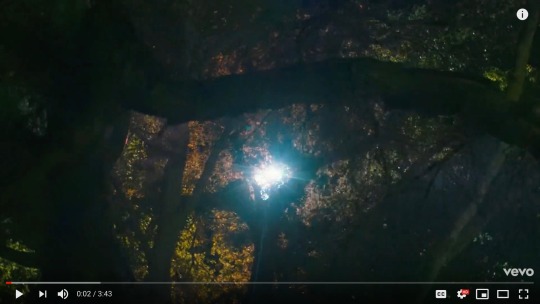

Selena is in a dark place, turning towards the sun’s rays. She is transported to a garden, where she lays asleep on the grass.
Sun pg 22
The nuclear fusion at the core of “our hot, stable, brightly burning star” (Greene, 171) convert 4,000,000 tons of matter into energy every second, a small amount of which supports life on earth. To sun worshippers over millennia, solar rays have seemed to transfer magical properties of fertility, creativity, prophecy, healing and even (for the alchemists) a living potentiality for wholeness that dwells in every individual. No wonder then that the sun has evoked the illustrious, worldy prestige and authority of rulers and royalty who were the sunlike crown, the world-transcending intelligence of the “enlightened one,” the pellucid vision of the haloed saint, and the solificatio or achievement of highest illumination by the initiate of mysteries.
Garden pg 146
Most often gardens are set apart from the pressures of ordinary life for pleasure and contemplation. In many languages the word garden signifies enclosure, bringing to mind walled gardens, secret gardens or mythical gardens - hidden, supernatural worlds transcending time and disorder. The garden paradise is the imagined locus of our beginning and end, the original matrix and mandala of life, fed by underground sources of living waters. The Garden of Eden, the Elysian Fields, the Pure Land or Western Paradise of Buddhism, the Garden of the Hesperides where Zeus and Hera were wedded are all enclosed paradisial garden worlds whose inhabitants are divinely protected. The paradisal garden variously reflects our fantasies of an idealized inner space of potential wholeness and hidden design, or a preconscious state of innocence and harmony. Medieval Christianity projected on the Virgin Mother the soul of the paradisal cosmic garden: inviolate, self-generating and contained.
The gates of entry to secret gardens are typically invisible, narrow, difficult to find. Just as in the processes of individuation one repeatedly circles the more accessible aspects of the personality, only gradually moving closer to the center, so in dream or myth one might have to circumanmulate the outer garden wall many times before the portal to the interior garden is revealed. Physical or imagined, gardens are often arranged to reflect designs of wholeness, a quaternary form, for example, with a fountain, tree or image of a deity in the center.
In almost all cultures and religions, the garden represents a sacred place, a uniting of the conscious self with its unconscious source. Muslims speak of gardens as states of bliss and call Allah “the gardener.” The spare gardens of Japan are commonly not viewable all at once; they gradually reveal themselves in spaces opening along pathways and waterways where one may stroll and contemplate. the Zen dry gardens, stripped to the very essence, convey the eternal through an abstract and mystical design, making gardening a path to enlightenment.
Selena has been transported by the sun to a sacred and safe magical garden so she can heal, grow, and transform into her best self.
Gardens are a feminine symbol (see here).
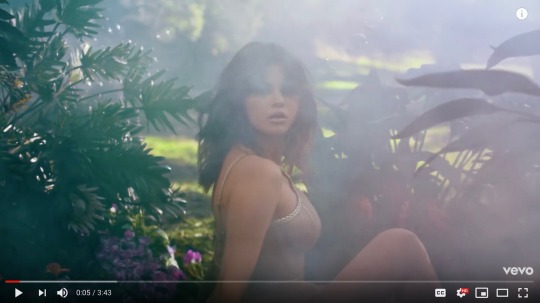
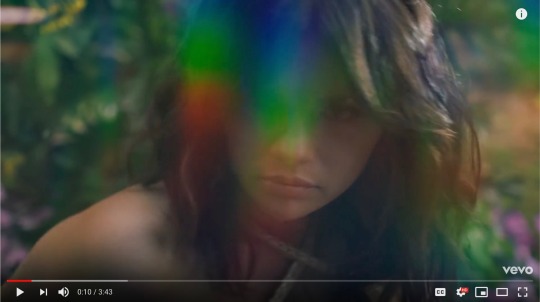
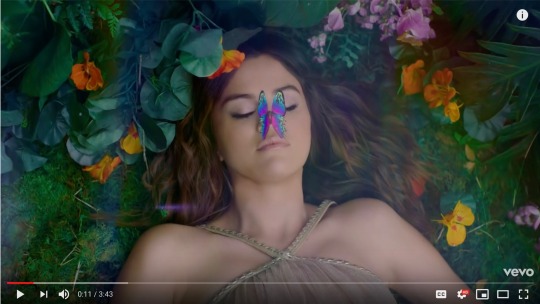
Selena wakes up after a rainbow butterfly moves up from her mouth (previous section) to her nose. The garden is full of bubbles and rainbow light.
Rainbow pg 72
Rainbow is the sign of renewal, the transmuting changes of the heart and the eros of covenant between heaven and earth. [cut] For many, however, the rainbow represents the imaginal bridge that links the visible world and all that is invisible, magical and supernatural. Fantasy peoples the rainbow’s unseen perimeters with angels, fairies and elves that guard abounding treasure, the bright gold and luminous pearls of wisdom, creativity and mercurial play. Myth has portrayed the rainbow as the highway over which psyche’s supernal emissaries bring their messages to consciousness. From the rainbow bridge the Japanese divine couple Izangi and Izanami stir the primal sea of potential with a jeweled spoon whose droplets coalesce into living matter. The spirits of the Hopi kachinas, or ancestors, descend from the celestial realm of the dead to the land of the living by means of the rainbow, whose earthly counterpart is the ladder descending into the kiva.
Butterfly pg 234
From ancient times the butterfly, psyche, has signified not only the mystery of physical metamorphoses, but also the lovelies transmutations of the soul. [cut] All over the world the gossamer beauty of the butterfly, its winged nature and breathtaking release from a pupal cocoon have symbolized the soul reborn out of chrysalislike containment. [cut] Like an alchemical vas, the chrysalis is both the “golden” (chryseos) vessel of transformation and the object transformed; swaying gently in the wind, it gives no outward sign of the concealed unfolding within as the old forms dissolve and the embryonic tissue is restructured. The butterfly is one of our most poetic images of psyche’s self-renewal beyond even traumatic endings.
Nose pg 362
The nose’s long biological development means that it connects our consciousness to the most ancient and intensely emotional parts of our brains, allowing an entire world to be recovered by the trailing scent of a Christmas spice - or in Proust’s case, by a madeleine dipped in lime-blossom tea - retrieving the soul of one’s past as can no other sense. The Egyptians understood that the breath passing through a goddess’ nostril to give eternal life to a deceased king would impart a fundamental reality, for the nose is like a forgotten portal to the archaeology of the psyche.
Bubble pg 52
In contrast, the archetypal symbol of a bubble exists in the psyche beyond time and space. It constitutes an invisible reality imaged by mystics throughout the ages, a round nothingness that is paradoxically the primordial source of all. The unseen forces within the archetypal bubble symbolize the oneness, [cut]. Throughout history, the translucent bubble has inspired contemplation of the infinite and the eternal. In ancient Egypt the Ba soul, or ghost that appeared after death, flew in and out of the tomb as a weightless bubble. Like the circle or sphere, the globular roundness of the bubble connotes oneness, wholeness, totality, completion and spiritual perfection. The translucency of the bubble introduces, in addition, the numinosity, ethereality and spirituality associated with the celestial light of heaven.
A rainbow is the most common queer symbol in modern times.
The rainbow butterfly symbolizes Selena’s inner soul, which is inherently queer and about to be transformed. She awakens only after the butterfly moves from her mouth to her nose; symbolizing that her soul is awakening so her whole self can be transformed.
The bubble symbolism continues to show us that the garden is a sacred, safe, and magical place of transformation.

A vibrant rainbow moves throughout the garden. We see the magical lifeblood running through Mother Earth’s veins. The garden is a safe space alive with spirit and transformation, just like a womb.
Womb pg 400
In traditional Native American rites and creation myths, Earth is the primary womb. [cut] Living beings - plants, animals, humans - emerge from their gestation deep within her womb, and return to it in death, to be born again. Thus the highest and most essential mysteries of the feminine are symbolized by the earth and its transformations (ibid, 47), and those reborn in rites of initiation describe themselves emerging as “fresh-baked pots” (ibid, 137).
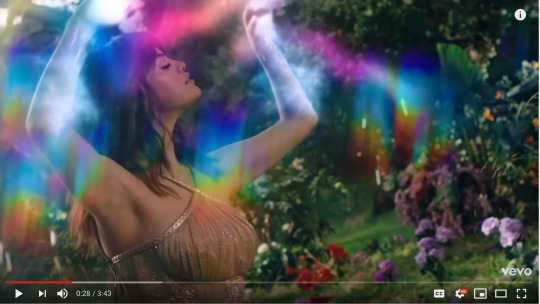
Selena stands in the middle of the rainbow. When her arms mimic the motions of wings, the white light of spirit/ether gathers on her arms.
Wings pg 240
In our desire for boundless freedom, we identify ourselves with the flight of birds. In our imagination we transcend the ordinary world by leaving the earth and the weight of the body. Wings lift us. “Hope is a thing with feathers,” says Emily Dickinson. Plato declared, “The function of the wing is to take what is heavy and raise it up into the region above where the gods dwell.” According to Black Elk, “The most important of all the creatures are the wingeds, for they are nearest to the heavens.” With wings we can look at things from both the perspective of earth and heaven at the same time. Intuition and inspiration seem to arrive unexpectedly on wings out of thin air as the first sign of any creative act. All kinds of winged beings connect us with the world beyond: the white dove of the Holy Spirit and Aphrodite, the black crow and raven, the angel, equally half-bird half-human, daimon and duende, as the voices of destiny, Mercury, the winged spirit of alchemy, the ancient shamans who flew to other worlds on their magical wings and imagination itself is winged. They return, each with their unique message.
Selena’s queer soul is starting to transform and transcend her old self.
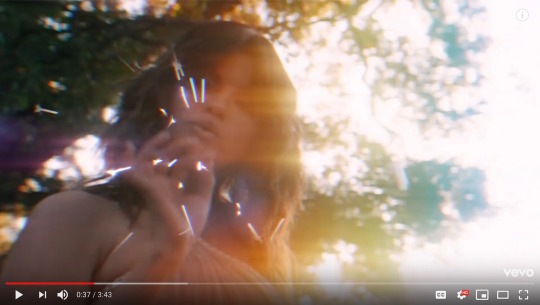
Selena’s fingers are creating sparks.
Spark pg 86
The origins of the word spark attest to its fertile, spermatic quality as well as its animating, vital essence. The Greek spargan means to swell, teem, abound and then break or burst forth, also relating to a sprout or germinating plant life. In Latin, spargere is to strew or scatter, as seeds of activating light might be sown in the darkness of fixity or stagnation (Partridge, 645). [cut]
Sixth century Greek philosophers talked of the soul being made out of star-stuff. The Gnostics saw the soul of a human as a spark or seed of light from the greater fire of God, [cut].
Selena is beginning to harness the power of her soul.

While there is a range of flower colors, a significant majority are purple. Purple is the bisexual color because it is the combination of red/pink and blue.





A lot more rainbow lighting as Selena’s soul continues to heal and transform.

Selena is in an outdoor pool with butterflies in her hair (I’ll go over the pool symbolism in a little bit). The butterflies symbolize her soul’s transformational process.

More transformation.

In a dramatic switch, Selena is now in a plastic room. Plastic is a synthetic material. The room symbolizes a fake (not authentic) and confined space. This is the polar opposite of the sacred garden.

Back to the garden, where Selena becomes one with a rainbow. This symbolizes that her authentic self is queer.

Selena has her head tilted towards the sun. There are bubbles in the air and dew on the spider’s web.
Dew pg 74
Science has explained dew as water droplets condensed from the air at night onto cool surfaces. This mystery of the darkness that leaves all the plant life glistening at first light has contributed to dew’s symbolic potency. For the ancients, the refreshment and cooling balm of the dew was evidence of divine visitation and divine gift - of Eos, or the rainbow messenger Iris, or the starry, overarching Egyptian Nut in her night-sky aspect. Because of its “heavenly” source, others saw in the dew tonic and panacea, even a mystical mirror in which the world was reflected. Buddhist literature speaks of Kuan Yin emerging from the center of the lotus with her vase of the “sweet dew” of compassion (Matthews, 94). Ethereal, evanescent, vanishing with the appearance of the sun, dew was the imaginal food of spirits, or the form that souls took following the cremation of the body (ERE 4:698).
Dew’s relation to both night and dawn has also made it a portent of transpersonal intervention and illumination. In the biblical Exodus, dew heralds the “manna,” the bread that God sends to feed the Israelites in the wilderness: “and in the morning dew lay round about the camp. And when the dew had gone up, there was on the face of the wilderness a fine, flake-like thing, white as hoarfrost” (16:13-4). For the early Christians, dew symbolized the gift of the Holy Spirit, a boon from heaven that revitalized parched souls. Borrowing in part from these sources, alchemy found in the dew a synonym for the aqua sapientia, the mercurial water of wisdom (Abraham, 53). Not merely an intellectual form of understanding, but incorporating feeling values, the “dew” alluded to psyche’s capacity to freshen and reanimate the personality desiccated by unconsciousness of its soul-stuff. The illumination of these contents, like glistening drops of dew, represents the “moisture that heralds the return of the soul” (CW 16:483ff).
Spider pg 220
Like a latticed window whose center looks on eternity, the spider’s web intimates the instinctual patterns of behavior out of which psyche’s dark and luminous agency is felt, mythically identifying the spider with divine creator, culture-hero, trickster and benefactor. In a Hopi creation story, Grandmother Spider lives in an underground kiva that mimics the trap-door spider’s dwelling and recall the Hopi’s emergence from the “underworld.” A Navajo tale describes Spider-Woman lodging behind the hero’s ear, whispering secret advice and mediating his transit between physical and subtle dimentions, all within life’s encompassing web. The spider Anasi of West African tradition is an unscrupulous buffoon but also a trickster that outwits larger creatures such as the elephant or lion (Courlander, 135). The spider’s ever-renewed, wheel-like web has been compared to the radiating sun. In Hindu Myth the veiled Maya is spinning the world of illusion out of her substance and drawing it back in.
Selena is embracing the healing and transcendant light of the sun. The dew and bubbles symbolize that her soul has transcended it’s old self and is now moving towards rebirth (the spider’s web symbolizes the dark womb where her soul safely transformed).

Selena has fully embraced her queer self and is now the embodiment of bisexuality.

Selena walks towards a statue of herself.

Selena is back in front of the spider’s web, we have gone back to her transformation process.
There is glitter on her palm. Glitter sparkles and shimmers, it’s a type of spark (see above). Selena’s soul is transforming and she is harnessing her ability to authentically shine.

She has taken the dew, her soul material, into her own hands.
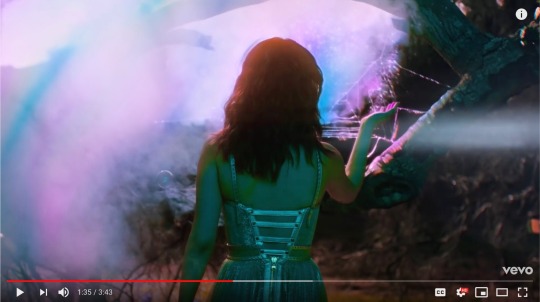
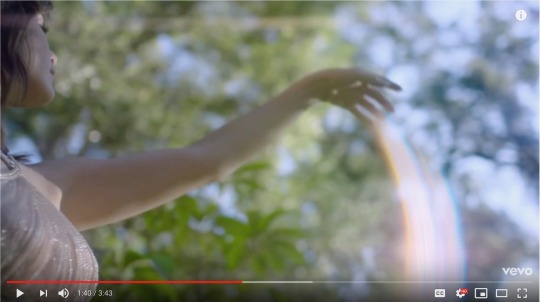
The video continues to cycle through day and night, showing Selena’s transformation process. Here she is making a rainbow of ether with her hand.
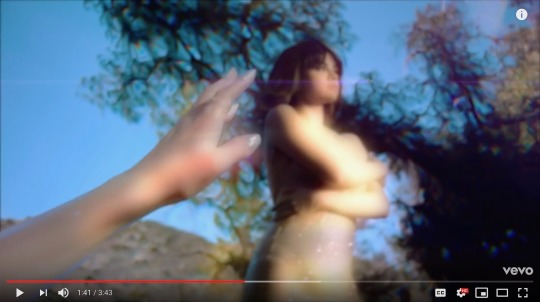
Selena is reaching towards the statue of herself.
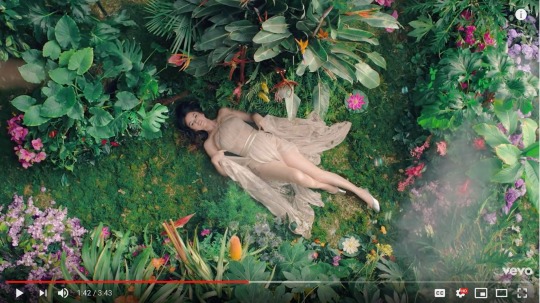
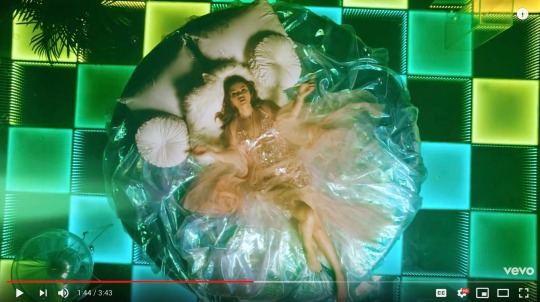
The scene switches from Selena taking a healing rest in the sacred garden to being stuck in synthetic confinement.
Bed/Bedroom pg 598
Distanced from the pressure and activities of daily life, the bedroom can be a timeless place, a haven of stillness. Here, one might be closest to one’s private self, shed one’s clothes, go to sleep and dream, perhaps make love or simply rest and recuperate from the pressures of the outside world.
But the bedroom can also be associated with exposure, nightmare, fear of the dark and supernatural visitation. One can be confined to the bedroom, even imprisoned there. In the bedroom are enacted incest, misalliance and conjugal war. Gnawing anxieties can fill the space emptied of the day’s welcome distractions. The bedroom houses sickbed and deathbed.

Selena is surrounded by bubbles, steam, and bi colored lighting while she is in the pool. The pool is another sign of transformation and renewal.
Pool pg 606
Thus, the pool in the Egyptian image is both domesticated nature and a small reservoir of the infinite brought into the midst of ordinary life. The product of human culture, the pool’s rectangular sides are a temporary collect for the ever-moving energies of both water and the spirit. There are many images in religion, psychology and myth that evoke a simple pool that contains the waters of continual renewal. These are the “still waters” of the 23rd Psalm, where amid green pastures God “restores my soul.” Isaiah enjoined “everyone the thirsts, come to the waters” for the soul’s refreshment (Isaiah 55:1). The baptismal font is a kind of miniature pool holding holy water for the sanctification of a child. Similarly, pools are used for the full immersion baptism practiced by some Christian denominations. The pool at Bathesda (John 5), when troubled by an angel, became a healing bath for the first person who immersed himself in it. At that site Jesus performed a miracle, making an infirm man whole.
The aphorism “Still waters run deep” hints at meanings far beneath the pool’s placid surface. In the symbolism of psychology, a pool of water represents the wellspring from which all psychic life flows (Whitmont, 72). These waters can be a perpetually replenished source of revivification or, left neglected, they can become a stagnant pool.

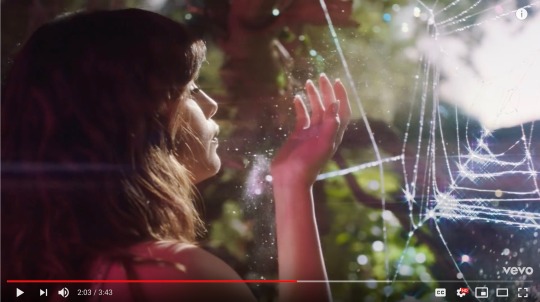
The video continues to cycle through Selena’s various transformational scenes. Then she blows the glitter (her soul’s shine) onto the sipider web; the dark womb of transformation.

Selena is back in the field of predominantly purple (bi) flowers.



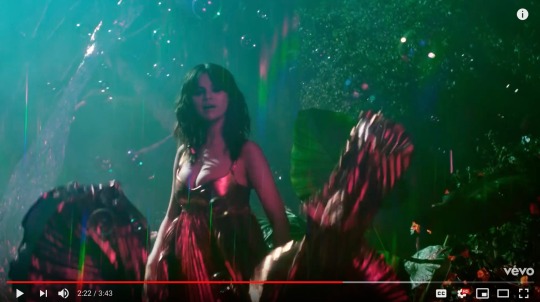
Selena continues to cycle through all the different parts of transformation process.
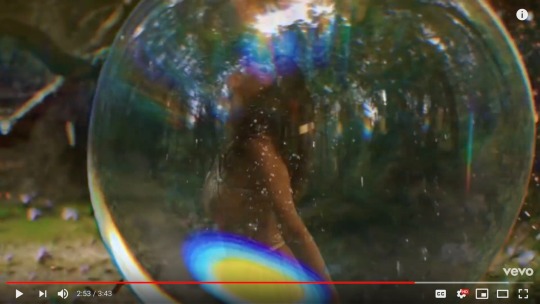

Selena starts out encased in a bubble, which then bursts open. She is emerging from sacred transformation as her authentic and whole self (see bubble symbolism above).

Selena lets the rain, bubbles, and rainbow light wash over her and nourish her soul.
Rain pg 62
The water upon which all of life depends descends to earth as raindrops both gentle and torrential. Rain precipitates growth, change, refreshment, purification and ... disaster. The image of rain in the mythologies of many peoples represents the penetration of the earth below descending celestial, fertilizing powers and points to the sacred marriage of heaven and earth.
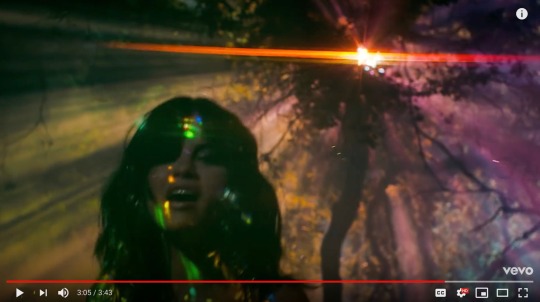
The sun that transported Selena to the garden shines bright here.
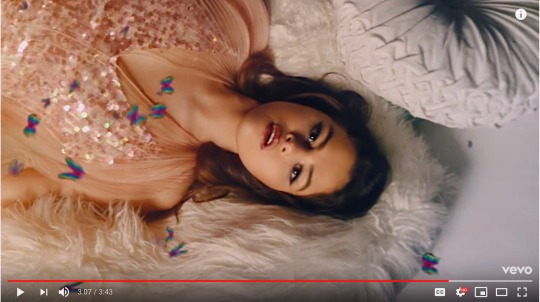
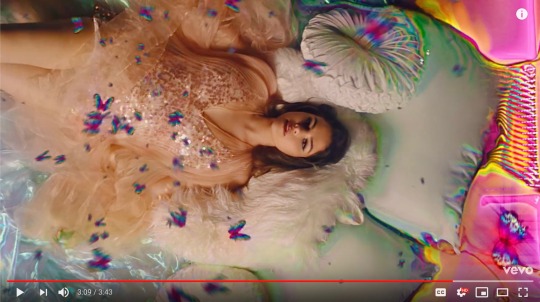

Back in Selena’s synthetic confinement, a multitude of rainbow butterflies emerge from her heart.
At the beginning of the video a rainbow butterfly symbolized the awakening of her soul. Now, her inherently queer soul releases itself into space it’s trapped in. She has transformed and is trying to get out so she can finally fly.
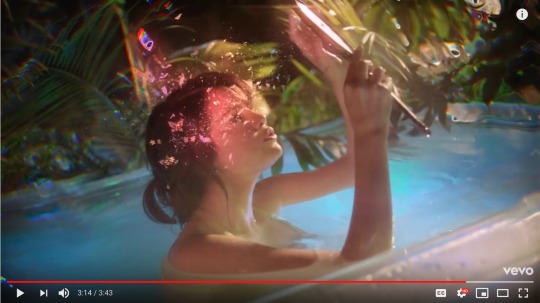
Rainbow butterflies emerge from the mirror to cover Selena.
Mirror pg 590
Mirrors have always existed. Before the use of metal, they were the reflections on the waters collected in the earth’s indentations. Early peoples believed that in such reflections the soul element could be perceived and even today the fantasy persists that the mirror can steal one’s soul. The association of the mirror with the essential nature of a thing is carried in the ancient Egyptian hieroglyph for life, the ankh, which was also one of the words for mirror. The mirror represented the solar disk as the source of light that contained life’s essence. Mirrors were placed in burial chambers and were also cult objects in the worship of Hathor, goddess of abundance, joy, music, dance, cosmetics and self-beautification, which brought one into harmony with the divine (ARAS, 2Ak.191). Our English word “mirror” comes from the Latin mirari, to wonder or marvel at.
Carl Jung said: True, whoever looks into the mirror of the water will see first of all his own face. Whoever goes to himself risks a confrontation with himself. The mirror does not flatter, it faithfully shows whatever looks into it; namely, the face we never show to the world because we cover it with the persona, the mask of the actor. But the mirror lies behind the mask and shows the true face. (Archetypes of the Collective Unconscious)
The mirror contains and shows Selena’s true self, her queer soul, which is symbolized by the rainbow butterflies.
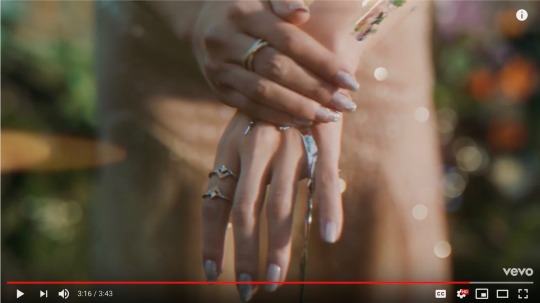
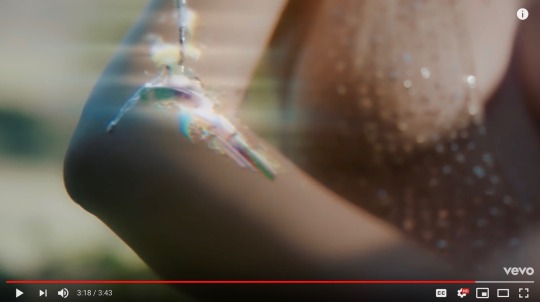


The last time we saw the statue of Selena, she was towards towards it. Now that she is completely transformed, she uses the dew (her soul material) to disintegrate her old exterior and illuminate her soul.

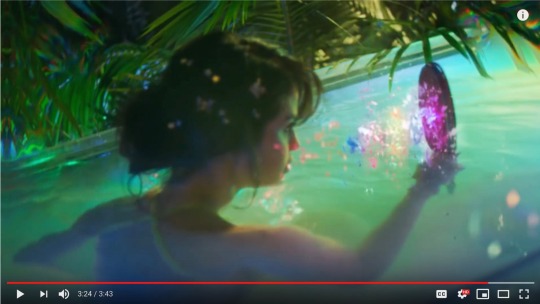
Another beautiful view of the rainbow butterflies emerging from the mirror.



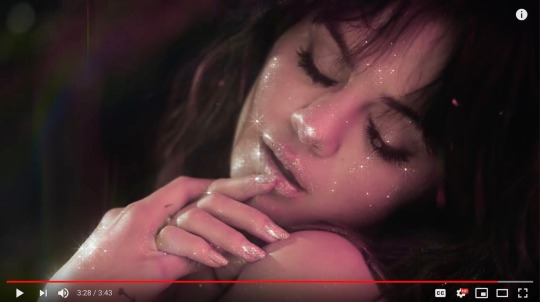
Selena goes from blowing glitter on the womb of transformation to embodying her soul’s spark.

More rainbow light.
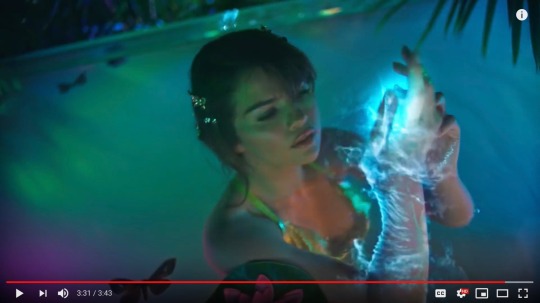

Selena has harnessed the power of her soul, which now shines out of the palm of her hand.
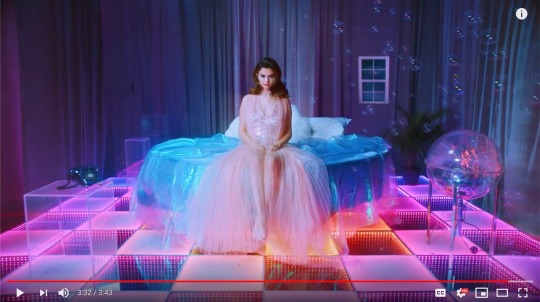

Selena has fully transformed and breaks free of her synthetic confinement, emerging into the natural world of Mother Earth.
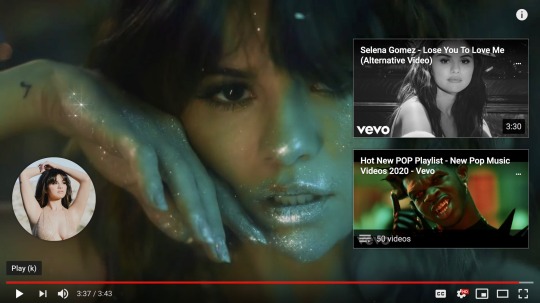
Her soul shines through her.

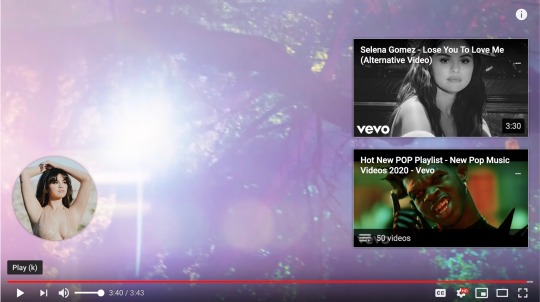
So she turns away from the sun, and is transported to our ‘real world’ Mother Earth.
0 notes
Text
Asexual Muslim resistance, activism, and self care: Creating Change 2017 and me
This post is for the February Carnival of Aces.
Author note: I originally intended to write this post soon after I got back from Creating Change a month ago. However, thanks to the start of my spring term Arabic classes the week after my return, to the emotional stresses of #MuslimBan that hit right after that, and to the need to get caught up on my other responsibilities while all this was going on, it’s taken me rather longer than I expected to actually get this post out!
I attended the Creating Change conference in Philadelphia from January 18 to January 22, 2017. I had several different goals for the conference, reflecting different facets of my identity and work:
connect in person with other aces
connect in person with other queer Muslims
attend anti-racism workshops to further my volunteer work with the Muslim Anti-Racism Collaborative (MuslimARC)
attend organization building workshops relevant to the needs of MuslimARC
attend sessions on spirituality and self-care to help me in coping with burnout
The fact that I could further my interests in so many different areas of my life is why I was so excited to attend the conference. MuslimARC is not an ace or queer organization but since I have access to the resources that Creating Change offers due to my own ace and queer identity, I figured I might as well take advantage of it.
To my delight, I was able to attain all of my goals for the conference and benefit in each of these areas of my life.
Due to the way my asexuality, my being a Muslim convert, and my accessibility limitations intersect, I have difficult in connecting with groups in my local area. The Muslim spaces nearby that I am able to get to are usually not welcoming to me and not places where I fit in at all. I have been making efforts for the last several years to show up anyway because I hoped that even a flawed space would be better than nothing, which is what I have otherwise and what I had for most of the time since I converted.
Creating Change offered a chance to participate in spaces that are more inclusive of my identities. These spaces were limited - just one panel and one official gathering for each of my core identities (the ace inclusivity panel and ace caucus on the one hand and the Islamophobia panel and jumu’a prayer service on the other) - or on the margins (the unofficial ace hospitality suite and the unofficial queer Muslim caucus) but they did exist. While I could see ways these groups might fall short of providing all the support I need on an ongoing basis, within the context of the conference just the fact that they were there at all was enough.
Beyond just finding community spaces where I could meet others who share identities with me, I was able to have deep conversations with David Jay and with queer Muslim activist leaders Imam Tynan Power and Palmer Shepherd telling them my personal story and the issues I experience and even advocating for greater inclusion of asexual Muslims. The Muslim Alliance for Sexual and Gender Diversity (MASGD), which both Ty and Palmer are actively involved with, has not made any efforts so far to reach out to asexual Muslims or even acknowledge in their public materials that we exist and I emphasized to Ty and Palmer how important it is to mention aces by name because otherwise we will assume that we are not welcome. Meanwhile, I gave DJ a reference to my Asexuality and Islam website and a printout of asexual Muslim data gleaned from the ace census, so that he can amplify these resources.
The most valuable thing about these three talks was that although each group represents only half of my identity by itself, I was able to share all of myself with them. These were probably the most deeply validating experiences of the whole conference for me. And while there is still no actual asexual Muslim community (a continuing frustration of mine), I hope that my work in these conversations can help other asexual Muslims as individuals find the same validation I did.
Meanwhile, as I attended the Racial Justice Institute and a session on building sustainable funding for nonprofit organizations, I found that I was able to reference MuslimARC frequently, contribute usefully to the conversations based on my experiences volunteering there, and learn some tools and frameworks that will be useful to MuslimARC’s work. I even decided it would be useful to list MuslimARC as my organizational affiliation at future Creating Change conferences to continue building in this area. This was a pleasant surprise.
Two other workshops I attended with a racial justice focus, the Police Violence Institute and the alternatives to law enforcement session, gave me something I hadn’t expected - an insight into how Creating Change can be useful to connect ace youth, especially those from marginalized backgrounds, to LGBTQ resources that already exist to help address the larger systemic issues they face. I was able to talk with the head of an LGBTQ center in Colorado about asexuality, discover that they are already seeing ace youth seeking out their resources, and connect them with Asexual Outreach to get information and resources on asexuality. The opportunities for networking at Creating Change are amazing and next year I might print out some resources from Asexual Outreach to be able to give to people!
On the spiritual front, I made use of the Many Paths Spiritual Gathering Place as a prayer room - with five daily prayers, the logistics of being Muslim at a busy conference can be tricky and having that dedicated space out of the crowds made things a lot easier. I got to know the spiritual care team there and through the centering care workshop and the session on building an authentic spiritual path. Because of the limited space provided for Muslims specifically at the conference, and because Ty is only one person, the spiritual care team ended up providing me with a lot of support and friendship I didn’t expect to receive. Beyond this, some of the practices and ideas I gained from these sessions are things I am slowly working to implement in my life back home with links to both queer spirituality and anti-racist self-work.
Speaking of the unexpected, the conference pushed me way out of my comfort zone in multiple ways. I was initially very anxious about wearing both hijab and obvious ace gear at an LGBTQ conference where I wasn’t sure either identity would be fully welcome - but I spent five days as a very visible asexual Muslim and most people hardly blinked.
I did experience a few microaggressions, all related to being Muslim (none were related to being ace). While I was attending the Police Violence Institute a white woman acted to me in a way that I found rather tokenizing (”I’ve never seen a queer Muslim before! Can I have your business card?”) and I had to spend several minutes educating her about effective allyship (build relationships with the affected community and learn what they need you to do, then do that).
Also, at the end of the ace caucus, a white ace came up and asked me if I was a nun (yes, I consider this a microaggression). I also got this question from a random stranger while I was buying food in Reading Terminal Market one afternoon. Still, I was expecting a lot worse than this and I was really very pleasantly surprised by how unfazed most attendees were by me. Shout-out to the hijabis who have attended past conferences and paved the way for me.
Besides wearing hijab and ace gear all the time, I ended up on stage during the opening plenary session (me? shy Laura?) and even attended the lesbian caucus. I wasn’t forced to come out as anything (except as Muslim because I was wearing hijab) since there was just a large group discussion I listened to but didn’t take part in. But this was the first time I had made a public connection for myself between being homoplatonic and lesbian identity. I’m still hesitant to identify as an asexual lesbian specifically, but I took a baby step that evening and I’m proud of myself for that.
As if all this wasn’t enough, I participated in the Philadelphia Women’s March draped in an ace pride flag (and wearing an ace pride hijab) and shouting slogans like “We’re here, we’re queer, we’re fabulous, don’t fuck with us” alongside Mary and Brian, which was pretty freaking awesome. Between that and being at a session on combatting Islamophobia and then at a queer Muslim prayer service during Trump’s inauguration, I figure I put a distinctively asexual Muslim stamp on my resistance that I plan to continue.
Creating Change 2017 was a life-changing experience that for the first time brought my whole self together in a single activist space. I’m still struggling every day with burnout but this was just the self-care I needed to help me get through a very tough time.
#carnival of aces submission#resistance activism and self-care#creating change conference#creating change 2017#cc17#ace-muslim's adventures in activism
36 notes
·
View notes
Text
Acts of Resistance, Week 2
This week in review. It’s been a hard week. People I know are struggling with some really hard stuff, both directly and indirectly connected to current events. A good friend of mine is very ill and in the hospital and may be near death (he’s lived a long full life, but still, hard stuff). And my roommate lost a coworker this week to depression and suicide, and that’s been incredibly hard for her. In happier news, K’s clinic space is getting closer to be finished, and she got to attend two births this week. I don’t know how long I’m really going to track daily activities, but for now it’s helping, so here goes:
Day 8: Held our first meeting of a newly formed Queer group at church. This is something K and I have wanted to get started for some time, and are finally doing it. Mostly the talk was about politics--even though this was intended to be a social group, not a political group, I think given the current situation, everything is going to be a political group! It feels good to be helping to make a additional safe space for queers. And it was good to connect with people in my community I don’t know that well.
Day 9: Our winter “family fun” event at church--a mini-retreat on the theme of “spiritual rejuvenation” (ok, rejUUvenation, actually). We’d planned to have two members of the congregation lead yoga and drumming/chanting as body practices, but they were both sick and couldn’t attend. We painted rock mandalas, did some simple soul collage, sang together, and talked about the idea of spirituality and how to better incorporate spiritual practice in our family’s daily lives. It was a lovely event, and definitely something I needed.
Also today, I replied to a facebook post by one of my few facebook friends who is an avid Trump supporter. She’s a member of the church, who volunteered for a brief time in the nursery a number of years ago. I don’t know her well. And I definitely don’t engage this way on facebook. But today I couldn’t let it go. I’ve watched over the past 6 months members of my congregation reply to her posts with love and conviction, and stayed out of it, because I’m staff, and because I don’t think facebook debates solve anything. But today she posted an opinion piece about immigration with the comment “I feel safer already” and I couldn’t stay silent. I commented that the ban affects not just new immigrants and refugees, but also current green card and visa holders, and that barring American residents from returning home is inhumane, and that none of this does anything to make us safer. I still don’t think debating on facebook is productive, but I felt compelled, and stuck to what I’ve seen modeled by the others in my community.
Day 10: Attended a CD release party and concert for my friend Kathleen Tracy. She’s a local UU and used to be my choir director when I attended Rainer Valley Fellowship when I first moved her. It felt so good to support her and her music and to be out doing something fun with my wife and in this community of super progressive people and it fed my soul. http://kathleentracy.com/music
Also today, joined Indivisible. I’ve been trying to figure out how to join, but there were like 12 groups in the Seattle area and none very close to me. But one of the folks at our queer group meeting pointed me to a secret facebook group for Washington state. So now I’m connected.
Day 11: Researched indivisible website, Read a post about “throwing sand in the gears” by commenting on proposed government regulations and researched that for a while: https://www.regulations.gov/, called Paul Ryan regarding ACA, called my rep and senators opposing immigration bans on Muslims (left voicemails, called after hours, but! step in right direction), and stored their phone numbers in my phone.
Day 12: Joined my local Buy Nothing group. Something else I’ve meant to do for some time, and finally did.
Day 13: Logged an official comment on the Environmental Impact Statement for the Army Corps of Engineers regarding DAPL
Messaged Sen. Feinstein as requested about why I marched:
I marched so that my sons could see and experience the power of people united for positive change.
I marched because my faith tradition teaches me to speak up for justice, and to stand on the side of love.
I marched to support and give voice to those who could not march.
I marched in honor of those who fought for rights I take for granted.
I marched to support rights for people of all races and all religions.
I marched to support rights for immigrants, for people with disabilities, for prisoners rights, and for my queer brothers and sisters.
I marched for economic equality and the hope that all may have what they need to live.
I marched because I am queer and do not want to lose my right to love whom I choose.
I marched because I am a woman do not want to lose the right to make decisions about my own body.
I marched because the ACA allows my children to have health insurance our family can afford.
I marched because we cannot live in a world devastated by pollution and poisons.
I marched because I believe in a better world, with peace, liberty, and justice for all.
I marched to remind myself that there is hope for the world.
I marched because I believe we are stronger together than we are alone.
I found reflecting on why I marched, as we reach the end of this two week period, helpful. As I look back over my “tiny steps” its hard to feel like it’s anywhere near enough, that it’s doing any good. And yet, I know it’s more than I’d be doing otherwise. I’m trying to stay encouraged by all the energy and engagement I am seeing around me.
Day 14: Today was a hard day. Not only did I not manage any specific action, I didn’t manage to write this post. Taking time to do so Friday morning instead. The best part of the day? Sitting with my boys while they took a bath, and being there and present with them, not trying to work or clean or do anything but be and appreciate them. They are growing into such awesome beings. And I realized (coupled with my why I march reflections from yesterday) that being present with my kids is in itself an act of resistance, and reminds me of what is important and why I need to keep at this and not give up.
1 note
·
View note
Text
~Original call for applications~ Tomorrow Is Ours! IBPOC Futurisms Workshop
*IBPOC: Indigenous people, Black people and people of colour (including those who identify as mixed-race)
✰✰✰✰✰✰✰✰✰✰✰✰✰✰✰✰✰✰✰✰✰✰✰✰
7-Week multi-disciplinary writing workshop. For Indigenous people, Black people and other people of colour (including mixed-race folks)
February 22nd – April 5th, 2016
Application deadline: Friday, February 10th
Apply here: bit.ly/2iAY5iy
Maximum 12 participants
✰✰✰✰✰✰✰✰✰✰✰✰✰✰✰✰✰✰✰✰✰✰✰✰
WHERE:
Vancouver Status of Women, 2652 East Hastings, Vancouver
✰✰✰
WHEN:
◆3 hour workshops
◆Wednesday evenings
◆6 pm - 9 pm
◆February 22nd – April 5th
(Please note: Facebook is no longer allowing event pages longer than 2 weeks. This is a 7-week workshop, not 1 day)
✰✰✰
WHY:
2016 was a difficult year, in the midst of difficult decades and centuries, for Indigenous people, Black people and other people of colour. The struggles we are facing are not new struggles, only the latest manifestations of the systems of oppression that seek to silence and erase us.
Now more than ever, we feel IBPOC voices are urgently needed in these times to lift up and give hope to ourselves, our people and broader communities. We're inspired by the incredible work being done by Afro-futurists and Indigenous-futurists in creating tangible and truly liberating futures for racialized people. Moving beyond reacting to the systems that oppress us and into future building for the world/s we want to manifest is work the universe urgently needs to hear, from our voices and perspectives.
We believe that writing workshops by and for racialized people are a critical, yet rare, resource for building loving and resilient communities.
We are constantly reacting, reaching outward, giving what we can and trying to survive in a system that eats up our bodies, our hearts, our spirits.
Instead, let’s move beyond the reactionary. Let’s move into the imaginative, the creative and the transformative. Together, let’s dream up radical alternatives to white supremacy and systems of oppression. Let’s take time together to imagine new futures and better worlds.
◆What are the futures we want, need and breathe?
◆What new worlds could we create beyond the limits of dominant science, society and power structures?
◆What would the world look like if we centered the knowledge systems from our own communities, spiritualities, and ancestries?
◆What if liberation had already been achieved?
◆What would this world, where we have achieved liberation by and for our people, look, taste, smell and feel like?
◆What are the steps to getting us there?
✰✰✰
WHO:
You are someone who:
◆wants to reach in and beyond your imagination
◆be part of a creative process that allows you to nurture your playfulness and be part of working to build radical alternatives for our futures
◆may or may not identify as a writer but who likes to write
◆wants to explore the connection between your mind, heart, body and spirit through writing and storytelling
◆is willing to reach into the realms of intuition, instinct and imagination to tap into visions of a liberatory world and/or worlds
◆is committed to anti-oppression principles and understanding the lifelong journey of learning and unlearning
◆is willing to take creative risks in a nurturing, loving group environment
We are:
◆Molly: Northern Coast Salish (Homalco/Klahoose), queer, mixed, urban indigenous, spoken word poet, facilitator and youth worker (more info coming)
◆Amal: Pakistani, brown mixie, Muslim, queer, performance poet, facilitator/educator (more info coming)
✰✰✰
HOW:
Workshops will use a combination of:
◆writing prompts and other methods of creative expression (visual, oral and more)
◆texts, audio, video, other resources and inspiration
◆interactive exercises
◆group discussions and individual writing time
◆optional sharing within a loving and reflective environment
✰✰✰
"Once the imagination is unshackled, liberation is limitless." Walidah Imarisha
✰✰✰
APPLY/COST:
If you have read all of the above and are feeling encouraged, we invite you to apply!
You can do so here: bit.ly/2iAY5iy
The deadline to apply is Friday, February 10th, (midnight pst).
Registration Fee: $300-$500
Note: We are doing this workshop without external funding. In order to allow us to do this sustainably, as Indigenous and Muslim artists and independent educators/facilitators, we have set a sliding scale registration fee of $300 - $500.
We also understand first hand the very limited resources available to Indigenous people, Black people and people of colour. We do not want registation fees to be a barrier for the very people who need this workshop the most - our communities.
We are calling on our allies in the community to support this work by donating funds. There are 12 spots available for this workshop series, open only to IBPOC. Our hope is that the registration fee for many of these spots can be covered by donations from allies. There is no guarantee of funds though we will do our best to fundraise. If, as an applicant, you are making a sustainable wage and/or are able to pay on a scale of $300-$500 for the registration fee, we welcome that. If you are able to pay less than $300-$500, we are looking to raise donations from allies to support your registration. There is also the possibility of paying in instalments or other payment plans. The amount you are able to contribute will not effect your eligibility to participate in the workshop. Just gives us a clear picture of how much money we are looking to raise to support this initiative. If you have questions about this- please reach out! [email protected]
Limited to 12 participants
✰✰✰
ACCESSIBILITY:
-The space is one level and wheelchair/scooter accessible throughout, including the entrance and the single stall, gender neutral washroom.
-Seating consists of two couches, some desk chairs and regular un-cushioned chairs, both with arms and without. There are also several large pillows and a lot of carpeted floor space for moving, stretching, etc.
- We’ll strive together to create a scent reduced space. We are however not the only ones using the space. There are some scented materials used for cleaning.
✰✰✰
Questions?
Email: [email protected]
✰✰✰
2 notes
·
View notes
Link
When somebody dies in the Catholic tradition, people generally know what to do. There’s the saying of the Last Rites at a dying person’s bedside, the vigil for the deceased — also known as a wake — and, often, a formal Mass of Christian Burial.
In the Jewish tradition, there’s the practice of sitting shiva: the week-long mourning process during which the family of the deceased remains at home, and friends and relatives call on them to pay their respects.
In the Islamic tradition, the deceased’s body is ritually bathed and shrouded in white cloth before Muslims of the community gather to perform the Salat al-Janazah, the customary prayer for the dead.
But what happens when you die and you don’t follow any faith tradition?
When Iris Explosion — an entertainer and social worker who prefers to go by her stage name — was widowed unexpectedly at age 28, she and her friends had to create the memorial service for her husband, Jon, from scratch.
Explosion and her husband were not conventionally religious — she describes herself as a “lax Jew,” while her husband, a queer man interested in alchemy and other occult practices, often felt alienated from the born-again Christianity of his parents. The memorial service her friends created a few days after his death, she says, contained a blend of traditions and practices individual to Jon.
A Jewish friend recited the Mourners’ Kaddish. The group told stories — some reverential, some “bawdy” — that reflected all aspects of Jon’s personality. They played an orchestral rendition of the theme song to Legend of Zelda, Jon’s favorite video game. Friends from out of town dialed in on Skype to share their stores. Numerous friends gave Explosion rose quartz, a stone associated in some New Age and occult traditions with heart healing, as a gift.
The memorial service — as well as a second funeral service, which took place a few months later, and was similarly eclectic in style — focused on Jon’s personality and interests rather than being constrained by a specific set of traditions.
Explosion is just one person among the 24 percent of Americans who identify as religiously unaffiliated. For the religious “nones,” the issue of what happens when you die is an open question in more ways than one. According to a 2008 American Religious Identification Survey, the most recent year for which data is available, 29 percent of Americans do not anticipate having a religious funeral, for whatever reason, and given the steady increase in religious “nones” over the past decade, that number will likely only rise.
But what do secular funerals — or death rituals more broadly — look like? What can they provide that religious death rituals can’t? What are the challenges involved in putting them together?
And as secular funerals become increasingly individualistic, tailored to the preferences and needs of the deceased, rather than a given religious or spiritual tradition, what does that mean for the sense of community engendered by ritual?
It started with weddings.
Scholar and psychologist Philip Zuckerman, author of Living the Secular Life, suggested in a telephone interview that secular funerals are just the latest iteration of the secularization of major life stages overall.
Its genesis, he said, lies in the proliferation of secular weddings in America. In 2017, just 22 percent of American weddings took place in houses of worship, a nearly 20-point drop from 2009, according to data from the wedding website the Knot.
“The first thing we saw was zillions of people going online and registering with the Universal Life Church,” said Zuckerman, referring to an organization that virtually automatically ordains people over the Internet, “so they can perform their own weddings for friends and family, so they can still make it sacred but not under the auspices of religion.”
Different states have different laws about the extent to which Universal Life ordinations are legally valid for performing weddings. Funerals, however, have no such restrictions.
Zuckerman posits that, among the people he’s interviewed for his book research, the desire to have a secular funeral isn’t just about not wanting to affirm the existence of a God or afterlife in which the deceased may or may not believe. Rather, he says, it’s also about wanting to preserve a sense of the deceased’s individuality.
“They just don’t want fairy tales. They don’t want to be told, ‘So and so’s in a better place now’ or ‘So and so is now suckling the bosom of Jesus’ — they can find that talk annoying,” Zuckerman said.
“We want to curate our own Facebook page. Why wouldn’t we want to curate our own funeral?”
More and more, Zuckerman said, he sees people choosing their own music and their own speeches that they want to be read after they die. “I think that is part of our growing individual and less of this care of tradition … more and more people want to feel the idiosyncracies of the dead person and the specialness of the dead person.”
This attitude, he said, is particularly prevalent in the United States. “We all like to think in the United States that we’re special. Why wouldn’t we want our funerals to be special, too?”
Certainly, for Iris Explosion, commemorating Jon’s life in a way that felt true to his personality and character was a priority. From sharing Jon’s favorite Spotify playlists with his friends to curate the music selection for the services to working in references to My Little Pony — a show Jon loved — Explosion and the couple’s friends created a memorial for Jon that befit his character.
By contrast, Explosion said, she declined to attend other memorial services, like one hosted by Jon’s family in his home state, that had a more Christian focus, instead circulating an email to attendees of that service asking them to donate to Planned Parenthood, which she felt better reflected her husband’s values.
Explosion’s experience dovetails with a phenomenon called religious “unbundling.” A term coined by Harvard Divinity School researchers Casper ter Kuile and Angie Thomas, who frequently cover how phenomena like Crossfit and Soulcycle function similarly to religions for their participants, “unbundling” refers to the way in which both the religiously unaffiliated and religious alike are increasingly willing to pick and choose elements of spiritual traditions.
Someone might, for example, be a committed Christian but also practice Buddhist meditation or yoga, or be an atheist but attend Jewish family holidays and read Tarot cards. In a pluralist landscape, in which people are used to gathering information and ideas from a multiplicity of sources (not least through the internet), a more individualized approach to religion and life rituals is all but inevitable.
Even for those of traditional faiths, death is a phenomenon that defies easy answers. But for the religiously unaffiliated, processing and dealing with death and its aftermath can be an especially loaded task.
Brad Wolfe is trying to help them do that.
Wolfe is the founder of the weeklong Reimagine End of Life festival. Wolfe, a singer-songwriter and author, was inspired to work in the end-of-life space after watching a close college friend’s struggle with terminal cancer. The festival, which takes place in New York and San Francisco, partners with community centers and artists to curate a 300-strong series of events — from talks to workshops to performances to museum displays — dealing with the subject of death.
“Death is often the central coalescing element around which many religions are formed,” Wolfe told Vox in a telephone interview. “As we’ve become more secular in some communities … there’s an increasing hunger for that space … to come together and explore this topic.”
“Death is often the central coalescing element around which many religions are formed”
The weeklong New York festival, which took place around Halloween, featured a range of explorations: a class on how to write your own obituary, doctors talking about dealing with their patients’ deaths, live musical performances dealing with the themes of loss and bereavement.
Participants speak at the the Nocturnists storytelling event where doctors from Mount Sinai, New York University, Columbia, and other local hospitals share their personal experiences with death. Courtesy of Reimagine End of Life
What connects each event, however, is a sense of intentionally: that people are actively setting aside time and space to deal with a weighty topic.
Both Wolfe and Zuckerman identify similar elements of what that “coming together” looks like. Ideally, both say, it involves elements of ritual, community gathering, and a sense of meaning: How do we conceptualize a person’s death as part of a bigger picture?
Wolfe suggested that we might be better off looking at this “coming together” not as a non–religious event, but as an expansion of the definition of what religion means. At least two Reimagine events are, fundamentally, immersive theatre performances. In one, participants are invited into a phone booth to have conversations they wish they’d had with somebody who has died.
In another, participants role-play members of a fictional bereavement support group. Speaking about these events, Wolfe argued that the lines between art, ritual, religion, and performance are deeply blurred.
“The boundaries between art and religion are more porous when it becomes a practice explored with intention,” Wolfe said. What matters is the sense of significance shared by participants: “Having a practice, a shared system, allows us to connect in ways that give us a sense of comfort and something we know we can turn to.”
The idea or combining artistic creation and end-of-life ritual is far from new to Janie Rakow, president of the International End of Life Doula Association. As a “death doula,” Rakow works in hospices, helping those facing the end of their lives develop rituals and practices around their own deaths. While she works with patients from a wide variety of religious backgrounds through the hospice, she tailors her work and approach to the individual in question.
One of the most important parts of the end-of-life process, she says, is the act of creation. She helps her patients develop what she calls “legacy projects”: individual artistic works, from a memory box to audio letters.
“Everyone has a legacy,” Rakow says. “So [I ask myself] what kind of legacy project could we possibly create with this person to really leave behind a sense of who they are or were?”
Next, she asks patients to help plan their own death — where they would like to be? What music they would like to be listening to?
“There may be some ritual work done around that,” she says, even if it’s “as simple as surrounding their bed, holding hands, saying a prayer or saying poetry, reading something to them, [or] lighting a candle.”
The point is to help the dying take an active, creative role in the story they leave behind.
Doula Craig Phillips pauses before entering the room of a person who is near death at the Gilchrist Hospice in Baltimore, MD on June 6, 2016. Katherine Frey/The Washington Post via Getty Images
Often, Rakow says, these rituals are tailored to individual passions. She gives the example of one man she worked with, who was dying from ALS, a degenerative neurological condition that prevented him from being able to move. With his wife, Rakow created a series of guided visualizations for the man, who loved hiking.
“And so we would bring him with his eyes closed on the most detailed and specific hike that we could from the very beginning to hiking all the way through.”
She’d walk him through ”smelling the forest and feeling himself walking up the hills and hearing the birds chirping and looking over at the crystal clear lake and the more descriptive we could get, we were able to bring him back into his body that he wasn’t able to use through his mind.”
One of the most difficult parts of creating secular death rituals is compensating for the lack of built-in community, or built-in structure, that often accompanies more established religious traditions.
Zuckerman pointed out that the secular bereaved don’t necessarily have a clear roadmap, or community support, to help them deal with the pragmatic aftermath of a death.
“One of the biggest problems for secular culture [is that] you have to cobble together and make it yourself. If you want your kid to have a Bar Mitzvah, it’s all taken care of. You want your kid to go through confirmation class in the Episcopal Church? Boom, they’re enrolled. If you want to do a secular version of that? Good luck. You’re on your own. You have to figure it out, explain it to people, rent the space, find people, figure out how to write up your own program. … It’s a lot of effort.”
The lack of intentional secular communities, Zuckerman said, only intensifies this problem. “With religious communities,” he said, “not only is the structure of the funeral in place, but there are going to be people who are going to immediately sign up to cook dinner for your family for a month and they’re going to deliver food to your doorstep and they’re going to help you get your kids to school and they’re going to do a lot for you. And when you’re secular you don’t have those kinds of resources.”
Pallbearers escort the casket to the altar during the funeral for Watertown firefighter Joseph Toscano at St. Patricks Catholic Church in Watertown, MA on March 22, 2017. Craig F. Walker/The Boston Globe via Getty Images
For some secular Americans, the idea of having a “chosen family” — a close-knit network of friends — helps fill in the gap. Just as Friendsgiving has become a phenomenon among urban millennials, so too have friendship networks more broadly become an increasingly vital part of social cohesion: replacing both extended family structures and traditional organized religious communities.
That was certainly the case for Explosion. She cites her friends’ involvement in making the service possible at a time when she didn’t feel capable of planning herself. “I needed camaraderie and community,” she said, and I feel like I had it.”
At the same time, she admits, she had less of a blueprint for how to cope with the next stages of grief after about six months.
“People go back to their own lives,” she said. “And it was hard to feel that sense of community. Without a church or synagogue to bind us together, it maybe felt like it dissipated. People missed their friend and their co-worker. But for me, it’s like — I miss my husband who lived with me, and it was hard to feel that sense of community after time had passed.”
Explosion’s story points to a wider tension in the world of secular funerals, and the creation of secular culture more broadly. On the one hand, the benefits of the “unbundled” religious landscape, for many secular Americans, lie in the opportunity to create truly new, individualistic rituals and experiences. We have the opportunity to curate our identities and public personae event after death, creating experiences that feel unique to us.
But on the other hand, what risks getting lost in the process is precisely that feeling of collective identity that demands subsuming our individuality in a wider whole. Religious rituals and language, from Catholic ceremonial liturgy to the Salat al-Janazah, may not feel fully and uniquely “us,” but they nevertheless define and orient a wider community and give us a sense of shared values.
The 19th-century sociologist Émile Durkheim saw religion primarily as a shared construction of identity; in his seminal 1912 work The Elementary Forms of Religious Life, he wrote, “The most barbarous and the most fantastic rites and the strangest myths translate some human need, some aspect of life, either individual or social.”
As more and more Americans leave organized religion, the next question is whether, and how, many of them will gather together, and how an increasingly individualistic conception of identity can be reconciled with the real, human need for group belonging. As secular funerals and death rituals become the new standard, we may see some of these rituals become more group-centric.
For Explosion, for example, the process of grieving led her to an unexpected new ritual. During her husband’s life, she said, she often played a video game called Destiny with him, looking up the location of objects hidden in-game and giving him hints to find them. While she never particularly got into the game herself, she said, she enjoyed playing it with him. After his death, she started watching YouTube videos of people playing the game, or its sequel, to remember the time they’d shared. Then, she decided to buy the game’s sequel to play it herself.
“I’ve been playing this game I wouldn’t have played if he hadn’t died. And it’s been meditative for me. Finding the little things, like doing these things we used to do, felt like a pilgrimage in a way.”
Sometimes, Explosion communicates with other players in the game online. While she’s only told a few of them about her personal history with the game, she’s nevertheless found a community that can accompany her in a time of grief.
“When we do a big quest or a raid together, there’s always a moment for me of, like, you know, okay, he would have done this. He did this in the old game. Now it’s me kind of picking up this mantle.”
The secular funeral liturgies we see in the future may transition from being individualistic to being based on other non-religious elements that bring a community together. They may involve the music of My Little Pony, or the playing of video games.
Ultimately, they’ll represent two fundamental human needs. First, to make sense of a beloved’s death. And second — and just as importantly — to not do it alone.
Original Source -> What does dying — and mourning — look like in a secular age?
via The Conservative Brief
0 notes